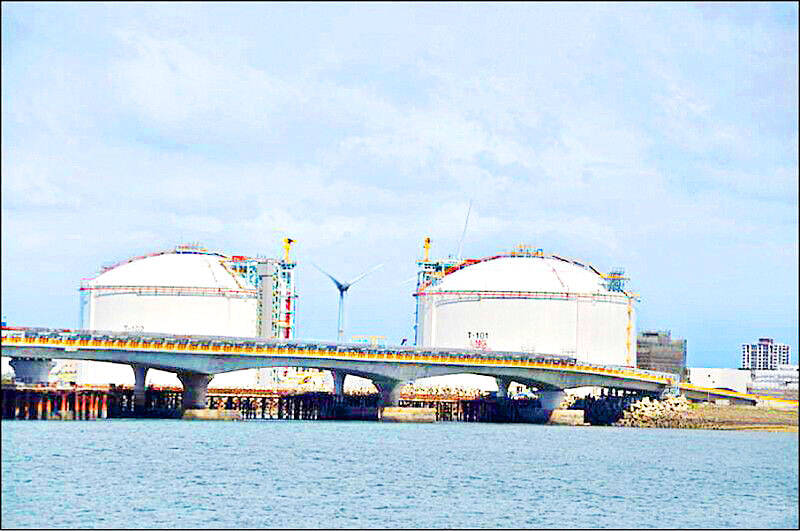State-owned oil refiner CPC Corp, Taiwan (台灣中油, CPC) is in early stage discussions to buy shale-gas-producing assets in the US, in a bid to secure natural gas supply to fuel Taiwan’s economy, three sources familiar with the matter said.
If a deal is struck, CPC would join a growing list of Asian companies taking ownership of US natural gas assets, gaining exposure to the commodity at a time when the US is expanding its export capacity by building more liquefied natural gas (LNG) plants.
Taiwan would also gain leverage with US President Donald Trump’s administration, which has linked imports of US energy with his tariff policy.

Photo: Taipei Times
CPC explored bids for assets held by public and private equity-backed gas producers active in shale formations that are well connected to existing or upcoming LNG plants, such as the Haynesville Shale in Texas and Louisiana, the sources said.
It has also considered bids for assets in mature plays, such as the Marcellus Shale in the Appalachian Basin, which have attracted more buyer interest over the past few years, as technological advancements have allowed operators to extract more hydrocarbons at lower drilling costs, they said.
The sources cautioned that a deal was not guaranteed, and CPC could still buy assets somewhere else.
Taiwan’s LNG imports have been rising steadily over the past 15 years, hitting a record 21.78 million metric tonnes last year, ship tracker Kpler data showed.
Some Asian companies, including CPC, have already bought stakes in various US LNG plants. Ownership in gas-producing assets can be a way for them to secure supply of the fuel to these plants.
In March, CPC signed an agreement with Alaska Gasline Development Corp to buy LNG and invest in the Alaska LNG project, which would transport gas south from Alaska’s remote north via pipeline and shipped as LNG to Taiwan, Japan and South Korea.
President William Lai (賴清德) said the deal would ensure the nation’s energy security.
CPC has also expressed interest in acquiring parts of private equity-backed Aethon Energy Management’s Haynesville assets, one of the sources said.
Aethon is in talks to sell the entire company to Japanese conglomerate Mitsubishi Corp, although a deal is not guaranteed, sources said.
Aethon declined to comment.
The Haynesville produces about 15.4 billion cubic feet per day, data from the US Energy Information Administration (EIA) showed, making it the third-largest gas producing region in the country and an attractive option for foreign buyers and investment firms.
The Appalachian Basin is the largest gas-producing region in the US, with output of 36.4 billion cubic feet per day, the EIA said.
CPC yesterday said that to enhance Taiwan’s energy security and self-reliance, it continues to diversify its layout and seek new sources of natural gas supply.
As the US has stable production capacity and a good investment environment, it has always been an area that CPC has been paying attention to, it added.
The company also does not rule out cooperation with promising prospects, CPC said, adding that it would make the best decision according to the assessment results and careful consideration of the nation’s energy policy.
Additional reporting by CNA

‘WIN-WIN’: The Philippines, and central and eastern European countries are important potential drone cooperation partners, Minister of Foreign Affairs Lin Chia-lung said Minister of Foreign Affairs Lin Chia-lung (林佳龍) in an interview published yesterday confirmed that there are joint ventures between Taiwan and Poland in the drone industry. Lin made the remark in an exclusive interview with the Chinese-language Liberty Times (the Taipei Times’ sister paper). The government-backed Taiwan Excellence Drone International Business Opportunities Alliance and the Polish Chamber of Unmanned Systems on Wednesday last week signed a memorandum of understanding in Poland to develop a “non-China” supply chain for drones and work together on key technologies. Asked if Taiwan prioritized Poland among central and eastern European countries in drone collaboration, Lin

The Chien Feng IV (勁蜂, Mighty Hornet) loitering munition is on track to enter flight tests next month in connection with potential adoption by Taiwanese and US armed forces, a government source said yesterday. The kamikaze drone, which boasts a range of 1,000km, debuted at the Taipei Aerospace and Defense Technology Exhibition in September, the official said on condition of anonymity. The Chungshan Institute of Science and Technology and US-based Kratos Defense jointly developed the platform by leveraging the engine and airframe of the latter’s MQM-178 Firejet target drone, they said. The uncrewed aerial vehicle is designed to utilize an artificial intelligence computer

Renewed border fighting between Thailand and Cambodia showed no signs of abating yesterday, leaving hundreds of thousands of displaced people in both countries living in strained conditions as more flooded into temporary shelters. Reporters on the Thai side of the border heard sounds of outgoing, indirect fire yesterday. About 400,000 people have been evacuated from affected areas in Thailand and about 700 schools closed while fighting was ongoing in four border provinces, said Thai Rear Admiral Surasant Kongsiri, a spokesman for the military. Cambodia evacuated more than 127,000 villagers and closed hundreds of schools, the Thai Ministry of Defense said. Thailand’s military announced that

CABINET APPROVAL: People seeking assisted reproduction must be assessed to determine whether they would be adequate parents, the planned changes say Proposed amendments to the Assisted Reproduction Act (人工生殖法) advanced yesterday by the Executive Yuan would grant married lesbian couples and single women access to legal assisted reproductive services. The proposed revisions are “based on the fundamental principle of respecting women’s reproductive autonomy,” Cabinet spokesperson Michelle Lee (李慧芝) quoted Vice Premier Cheng Li-chiun (鄭麗君), who presided over a Cabinet meeting earlier yesterday, as saying at the briefing. The draft amendment would be submitted to the legislature for review. The Ministry of Health and Welfare, which proposed the amendments, said that experts on children’s rights, gender equality, law and medicine attended cross-disciplinary meetings, adding that